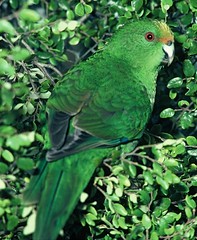 Orange-fronted parakeet Photo: Department of ConservationTuhua (Mayor Island) could soon hold the country’s largest population of the rare orange fronted parakeet/ kakariki if a recent Department of Conservation initiative to re-establish them on the island is as successful as they anticipate.
Orange-fronted parakeet Photo: Department of ConservationTuhua (Mayor Island) could soon hold the country’s largest population of the rare orange fronted parakeet/ kakariki if a recent Department of Conservation initiative to re-establish them on the island is as successful as they anticipate.
The orange-fronted parakeet is listed as critically threatened and has been extinct in the North Island since the late 1800s.
Tuhua Trust Board Chair Magda Williams says the Board welcomes the opportunity to provide a safe haven for these taonga by facilitating their return to the North Island once again.
“This is a responsibility that we take very seriously and one day we hope that populations from Tuhua will assist in re-establishing the species to the mainland.”
Ms Williams says; “Given its predator free status, Tuhua is a perfect habitat for the kakariki and we believe that, like the other endangered species on the island, they will thrive.”
“The Board is playing a major role nationally by contributing to the restoration of a number of threatened native species. It is already home to a small but thriving population of North Island brown kiwi as well as the pateke (brown teal), tuatara and toutouwai (North Island robin),” she says.
The first group of eight orange-fronted parakeets were sourced from the South Island and accompanied by Ngai Tahu representatives when they were welcomed onto Tuhua by representatives of Te Whanau A Tauwhao ki Tuhua last December. A second group of ten birds was successfully transferred by DOC staff this week with the assistance of the Tauranga Coastguard TECT Rescue boat and crew.
“This is an historic event for Te Whanau A Tauwhao ki Tuhua and we have acknowledged Ngai Tahu for this precious gift to the people of the north,” said Ms Williams.
Translocations will continue of captive-reared birds for the next one to two years until the Department is satisfied that the population has established successfully. It is likely that Tuhua will be the only place in the North Island for the immediate future where the public may be able to see these kakariki in the wild. The project has been made possible through sponsorship from BDG Synthesis and the Isaac Wildlife Trust.
Just 100 – 200 of this kakariki species remain in the wild. Until the recent releases on Tuhua, these have all been located within a 30 km radius in beech forests of upland valleys within Arthur’s Pass National Park and Lake Sumner Forest Park in Canterbury, South Island.